

Note: Most of the links on this page bring up images of the topic being
discussed. A new page will open. This method is used due to space
considerations. Clicking on an image will bring up a 1024 by 768 version of the
image.
Jerusalem is a fantastic city of contradictions: ancient yet modern, pluralistic yet monolithic. My original purpose for being there was to present information at Yad Vashem on the art of teaching about the Holocaust using the Internet, but I knew there would be much more to learn as we toured Jerusalem. The trip from the Ben Gurion Airport in Tel Aviv was uneventful and fascinating as we drove through the Judean hills towards our hotel, which seemed to be on the edge of Israeli-held territory, overlooking what looked like the occupied West Bank. Our hotel is actually part of a kibbutz at Ramat Rachel, which was situated just southeast of Jerusalem, overlooking Palestinian settlements in what appeared to be a modern Bethlehem. One could not help but think the long structure in the image at left was the security wall the Israelis were in the process of building. The wall is symbolic of the inner conflict within the soul of Israel: how to be a pluralistic democracy when surrounded by hostile neighbors; indeed, how can Israel contribute to the peace process if it feels the need to occupy territory obtained militarily a quarter-century ago?
|
Our first foray into the Old City was at night. We were assigned
a tour guide and a young Israeli soldier
who carried what looked like was an older carbine-style rifle. Security was
tight around the city with soldiers placed at the main gates and at historical
sites, and these on-duty soldiers were equipped with high-powered machine guns, ostensibly
Israeli-made Uzis. We entered the Old City through the Zion
Gate, which is linked to a wall build during the Ottoman Empire period in
the 1600s. There were bullet holes visible in the wall, but it was unclear which
conflict generated these indentations. We walked through the Jewish Quarter of
the Old City, arriving at the Wailing "Western" Wall. It was
impressive at night, but I knew we would have to return to see the Dome
of the Rock and the remains of the Second Temple during the day. Our group continued through the Jewish Quarter, passing some well preserved Roman ruins, but never venturing into any part of the Arab or Armenian quarters of the city. Naturally, the safety of the tourists could not be guaranteed once we ventured into those sections, so we would save our visit to those sites when we were not part of a tour group. We ventured up to the heights overlooking the city by walking along a wall and railing, so eventually we were overlooking the Mount of Olives with a beautiful nighttime view. My brother and I made the trip into the Old City once again later that week but during the day. We experienced the Jerusalem cabbies with bravery, but they were gentle drivers. Most often Arab in ethnicity, I took the chance of asking them how they felt about living in Israel. Both were Israeli citizens. One was complacent about his station in Israeli society, content to be a cab driver, not really interested in politics. Another was more vocal, more outspoken about feeling like a second class citizen as a Muslim Arab in a nation designated as "The Jewish State." My brother wanted me to end the conversation, so I did not pursue it, but I wanted to know how Israelis, both Jewish and Arab, reconciled their status as the Jewish homeland with the presence of non-Jewish citizens in their midst. |
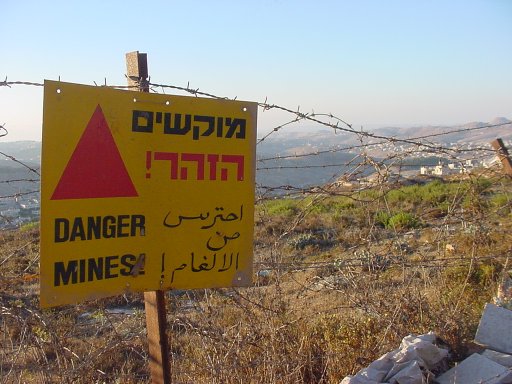
|
Once we found ourselves in the Old City again, it was up to us
to find the Via Delarosa, or "Way of Pain." It was here that Jesus
walked with the cross to Golgotha where he was crucified. I had heard about the
"Jerusalem
Syndrome," where tourists found themselves in a state of spiritual ecstasy
because of their proximity to the footsteps of Jesus. I wondered if I would be
overwhelmed with emotion as we traced his steps. Instead, we 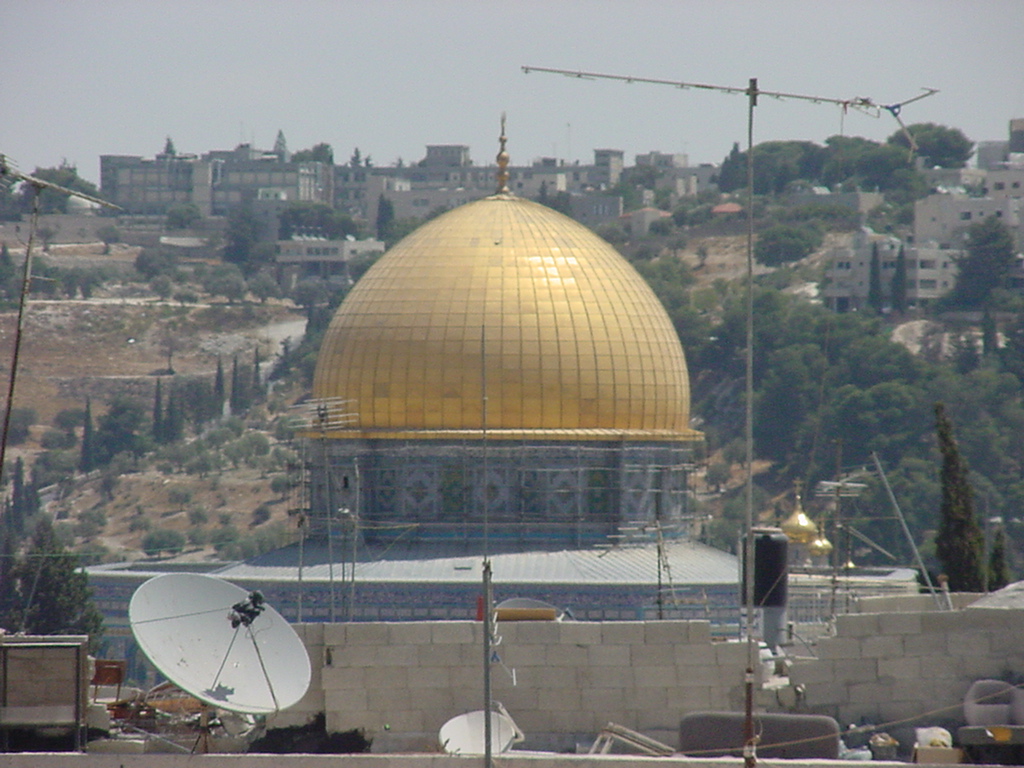 were overwhelmed by
offers of purchasing the locally-made trinkets cheap by storekeepers on every
side. One storekeeper used his knowledge of the Old City to give us a special
look at Jerusalem that most tourists would not get. He
was a Bedouin Christian Arab who asked us to call him "Al," and he
had a great commend of English and of western culture. He said he had lived in
the United States for a while, and that he still had family there. He quickly
took up up the steps behind his shop to the rooftops overlooking the Arab
Quarter. Again the ancient and the modern were in stark contrast: the Dome of
the Rock was clearly visible, but it was surrounded by
satellite dishes and TV antennae
peering above the Jerusalem shops. These aspects of modern technology were not
visible from the small alleyways of the Arab Quarter.
were overwhelmed by
offers of purchasing the locally-made trinkets cheap by storekeepers on every
side. One storekeeper used his knowledge of the Old City to give us a special
look at Jerusalem that most tourists would not get. He
was a Bedouin Christian Arab who asked us to call him "Al," and he
had a great commend of English and of western culture. He said he had lived in
the United States for a while, and that he still had family there. He quickly
took up up the steps behind his shop to the rooftops overlooking the Arab
Quarter. Again the ancient and the modern were in stark contrast: the Dome of
the Rock was clearly visible, but it was surrounded by
satellite dishes and TV antennae
peering above the Jerusalem shops. These aspects of modern technology were not
visible from the small alleyways of the Arab Quarter.
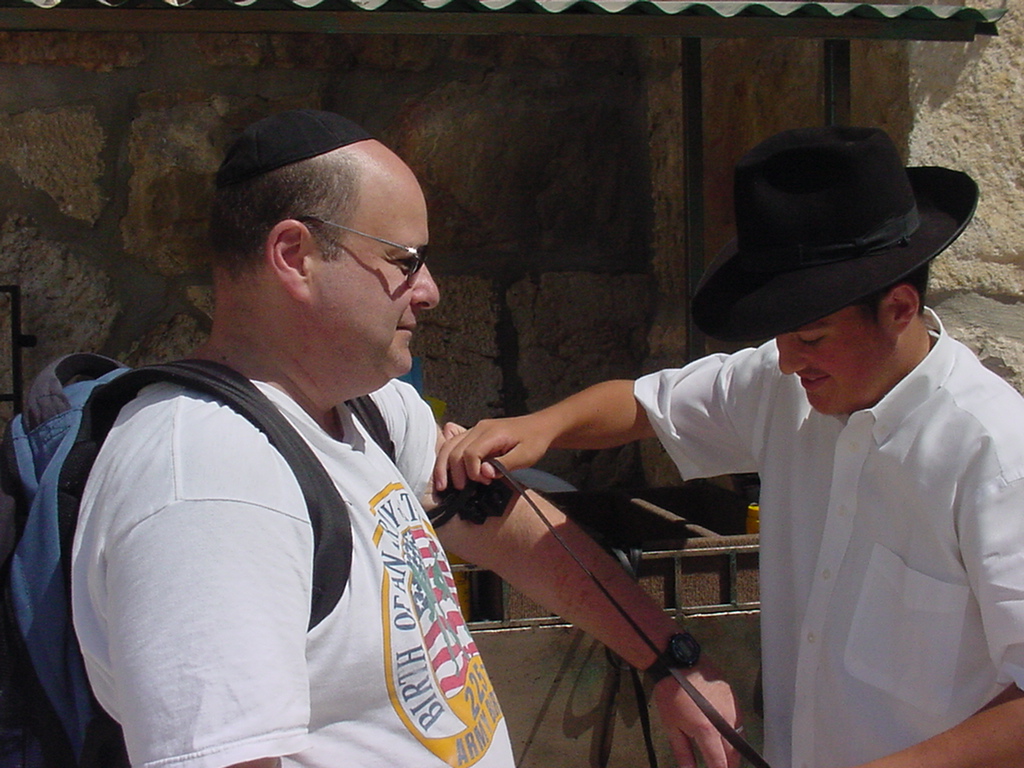 My
brother recognized the significance of the moment as we stood near the Wailing
Wall. We were approached by a young Jewish activist, a member of the Lubavitcher
sect, whose stated goal was to help Jews fulfill their religious heritage by
providing them with the tools to pray properly while at the holiest site in Judaism. He
offered my brother the leather boxes known as phylacteries, with the straps orthodox
Jews use to place the scripture on their hearts and on their heads. I responded
that I much more wanted to be the historian, the observer, but Ben took the
religious items and said a blessing in Hebrew. While at the Wailing Wall, we
also witnessed a bar mitzvah, the rite of passage of a young Jew from
boyhood into manhood at the age of thirteen as well as a wedding party.
My
brother recognized the significance of the moment as we stood near the Wailing
Wall. We were approached by a young Jewish activist, a member of the Lubavitcher
sect, whose stated goal was to help Jews fulfill their religious heritage by
providing them with the tools to pray properly while at the holiest site in Judaism. He
offered my brother the leather boxes known as phylacteries, with the straps orthodox
Jews use to place the scripture on their hearts and on their heads. I responded
that I much more wanted to be the historian, the observer, but Ben took the
religious items and said a blessing in Hebrew. While at the Wailing Wall, we
also witnessed a bar mitzvah, the rite of passage of a young Jew from
boyhood into manhood at the age of thirteen as well as a wedding party.
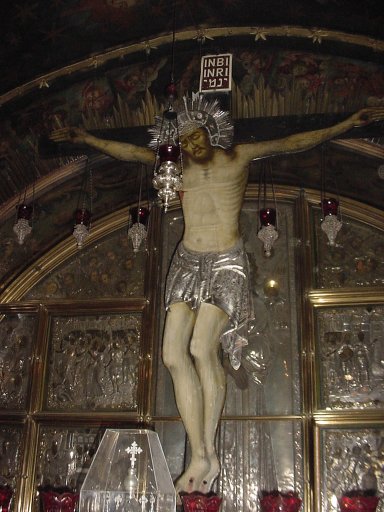 We
did make our way to the Church of the Holy Sepulcher, one of the sites where
Christ was allegedly crucified. We entered the church, passing the heavily armed
Israeli guard in the courtyard. The church was built by the mother of Roman
emperor Constantine in the Fourth Century, but it was destroyed by invading
Muslims, and later rebuilt. The passage of time masked the spiritual
significance of the site. Rather than building the image Christian artwork portrays,
where Christ was crucified on a barren hill, the church creates a more medieval
scene, with its ornate decorations and fortress-like walls and chambers. The
statue of Christ crucified was moving, and we ducked into a small chamber where
the body of Jesus supposedly lay. While standing there, it was hard to conceive
of the idea that you were looking at the exact location where the Resurrection
took place. No religious ecstasy seemed imminent. There was just too many layers
of history surrounding the place to feel what millions found to be spiritual
truth. Indeed, my own faith continued to require of me that I believe in what
was not seen, that which was hidden by the years, the wars, the bricks and the
bloodshed rather than what was physically before me in real time.
We
did make our way to the Church of the Holy Sepulcher, one of the sites where
Christ was allegedly crucified. We entered the church, passing the heavily armed
Israeli guard in the courtyard. The church was built by the mother of Roman
emperor Constantine in the Fourth Century, but it was destroyed by invading
Muslims, and later rebuilt. The passage of time masked the spiritual
significance of the site. Rather than building the image Christian artwork portrays,
where Christ was crucified on a barren hill, the church creates a more medieval
scene, with its ornate decorations and fortress-like walls and chambers. The
statue of Christ crucified was moving, and we ducked into a small chamber where
the body of Jesus supposedly lay. While standing there, it was hard to conceive
of the idea that you were looking at the exact location where the Resurrection
took place. No religious ecstasy seemed imminent. There was just too many layers
of history surrounding the place to feel what millions found to be spiritual
truth. Indeed, my own faith continued to require of me that I believe in what
was not seen, that which was hidden by the years, the wars, the bricks and the
bloodshed rather than what was physically before me in real time.
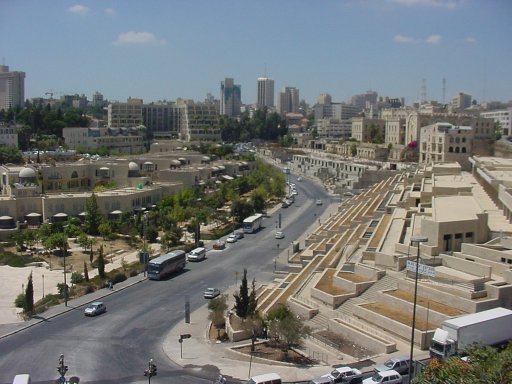 Our
journey took us around to the Christian Quarter, where the Jerusalem 's Tower
of David Museum gave us an impressive
panorama of the entire city. The museum integrated the modern and the
ancient by incorporating the exhibits within the historic walls of the fortress.
The museum is scattered within the walls of the Citadel
of old Jerusalem, but from those walls the landscape of modern Jerusalem can
be seen. Exhibits on the movement of people within the Middle East and the
architecture of the Second Temple were just some of what could be learned by
wandering the ramparts of the museum.
Our
journey took us around to the Christian Quarter, where the Jerusalem 's Tower
of David Museum gave us an impressive
panorama of the entire city. The museum integrated the modern and the
ancient by incorporating the exhibits within the historic walls of the fortress.
The museum is scattered within the walls of the Citadel
of old Jerusalem, but from those walls the landscape of modern Jerusalem can
be seen. Exhibits on the movement of people within the Middle East and the
architecture of the Second Temple were just some of what could be learned by
wandering the ramparts of the museum.
Religion permeates the cultural atmosphere of Jerusalem. The three major "religions of the book" claim the city as their own, and this tension is palpable as you make your way through its narrow streets or broad avenues. It is not altogether clear how the city will continue into the future as Israel's spiritual capital, the place where Christians call the birthplace of their faith, or the eventual capital of an independent Palestinian state. The ancient and the modern continue their quarrelsome marriage in Jerusalem, bringing with them all the memories and anguish that contentious relationships bring. If the city did become an "international city," as was once proposed, each religion and people would gain something, namely peace, but each would also lose a vital part of its identity. And so the tension of the three faiths, arising from centuries of history, continues.
All Images © George Cassutto, 2004